Human Resource Management Report: HRM Functions, Objectives, Metrics
VerifiedAdded on 2022/09/15
|7
|1350
|20
Report
AI Summary
This report delves into the core aspects of Human Resource Management (HRM), examining the fundamental organizational objectives that HR functions are responsible for, such as enhancing production, improving service quality, and fostering a diversified workforce. The report explores the evolution of HRM, contrasting past practices with contemporary demands, highlighting the shift towards strategic interventions including talent acquisition, training, and development, and the creation of attractive work environments. Furthermore, the report assesses the methods for evaluating the contribution of HRM, detailing the use of metrics like absenteeism rates, employee productivity, Key Performance Indicators (KPIs), Service Level Agreements (SLAs), staff surveys, and benchmarking, alongside the application of the Return on Investment (ROI) metric and HR dashboards for measuring the effectiveness of HRM interventions. References from leading HRM scholars are provided to support the analysis.
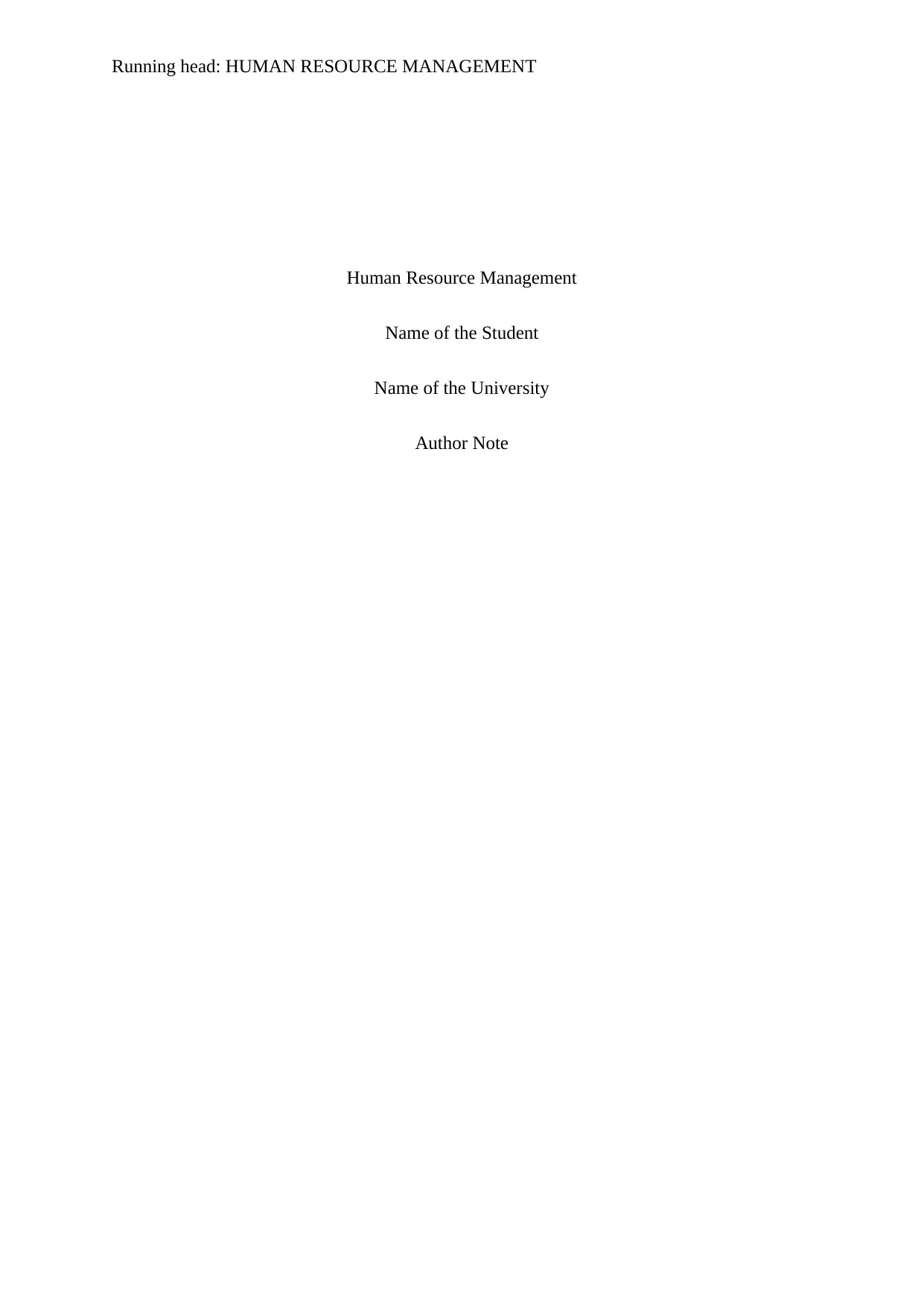
Running head: HUMAN RESOURCE MANAGEMENT
Human Resource Management
Name of the Student
Name of the University
Author Note
Human Resource Management
Name of the Student
Name of the University
Author Note
Paraphrase This Document
Need a fresh take? Get an instant paraphrase of this document with our AI Paraphraser
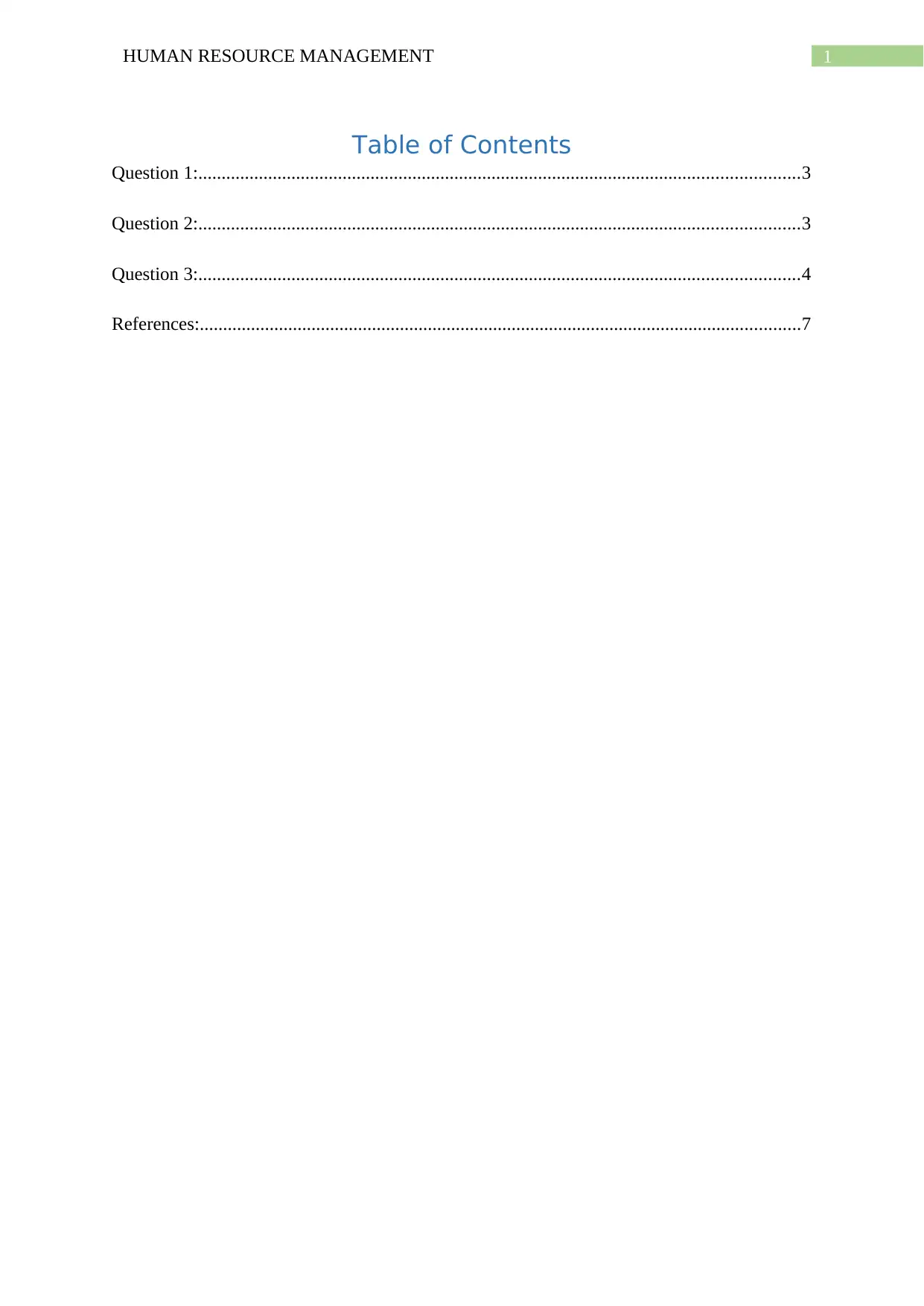
1HUMAN RESOURCE MANAGEMENT
Table of Contents
Question 1:.................................................................................................................................3
Question 2:.................................................................................................................................3
Question 3:.................................................................................................................................4
References:.................................................................................................................................7
Table of Contents
Question 1:.................................................................................................................................3
Question 2:.................................................................................................................................3
Question 3:.................................................................................................................................4
References:.................................................................................................................................7
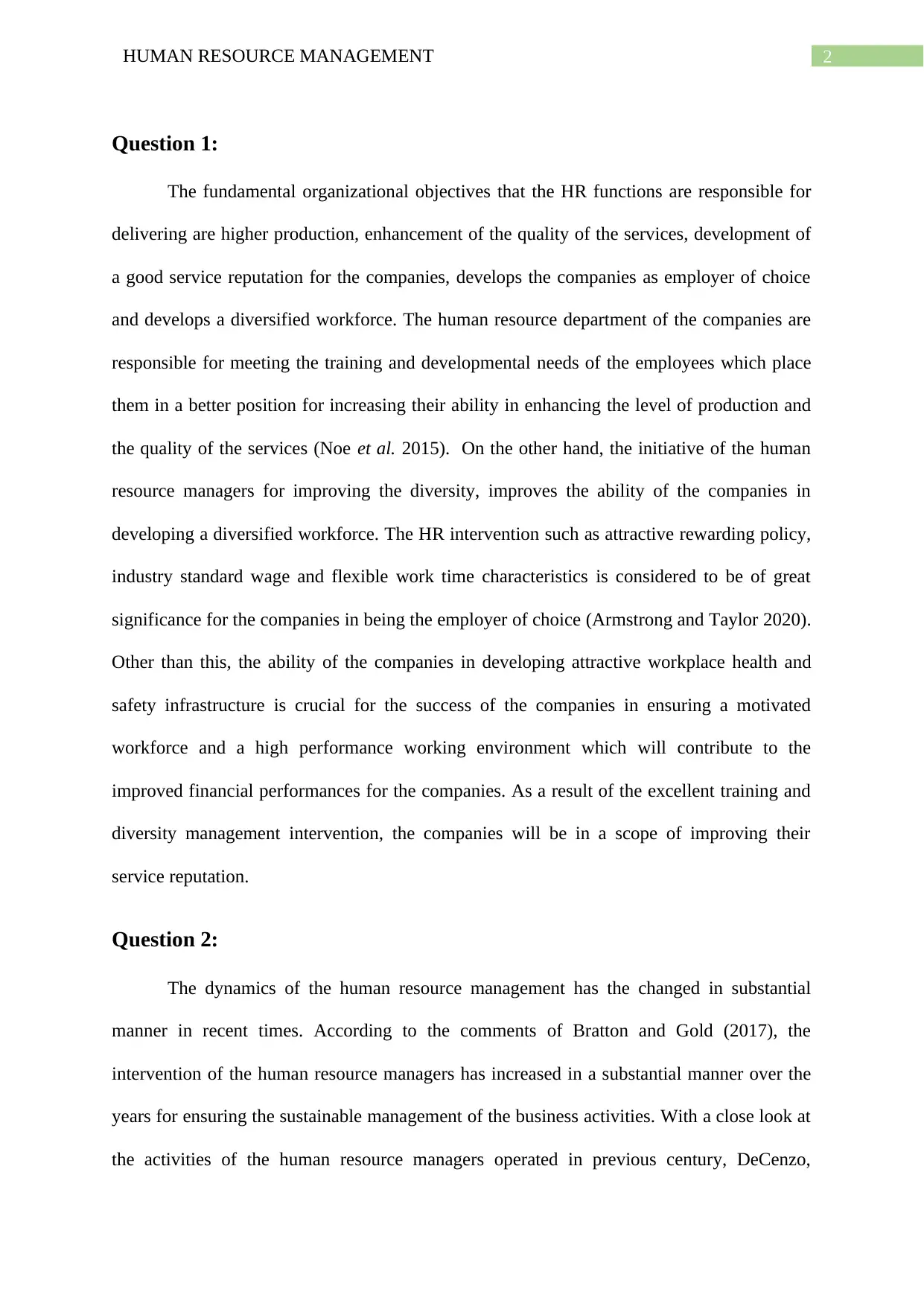
2HUMAN RESOURCE MANAGEMENT
Question 1:
The fundamental organizational objectives that the HR functions are responsible for
delivering are higher production, enhancement of the quality of the services, development of
a good service reputation for the companies, develops the companies as employer of choice
and develops a diversified workforce. The human resource department of the companies are
responsible for meeting the training and developmental needs of the employees which place
them in a better position for increasing their ability in enhancing the level of production and
the quality of the services (Noe et al. 2015). On the other hand, the initiative of the human
resource managers for improving the diversity, improves the ability of the companies in
developing a diversified workforce. The HR intervention such as attractive rewarding policy,
industry standard wage and flexible work time characteristics is considered to be of great
significance for the companies in being the employer of choice (Armstrong and Taylor 2020).
Other than this, the ability of the companies in developing attractive workplace health and
safety infrastructure is crucial for the success of the companies in ensuring a motivated
workforce and a high performance working environment which will contribute to the
improved financial performances for the companies. As a result of the excellent training and
diversity management intervention, the companies will be in a scope of improving their
service reputation.
Question 2:
The dynamics of the human resource management has the changed in substantial
manner in recent times. According to the comments of Bratton and Gold (2017), the
intervention of the human resource managers has increased in a substantial manner over the
years for ensuring the sustainable management of the business activities. With a close look at
the activities of the human resource managers operated in previous century, DeCenzo,
Question 1:
The fundamental organizational objectives that the HR functions are responsible for
delivering are higher production, enhancement of the quality of the services, development of
a good service reputation for the companies, develops the companies as employer of choice
and develops a diversified workforce. The human resource department of the companies are
responsible for meeting the training and developmental needs of the employees which place
them in a better position for increasing their ability in enhancing the level of production and
the quality of the services (Noe et al. 2015). On the other hand, the initiative of the human
resource managers for improving the diversity, improves the ability of the companies in
developing a diversified workforce. The HR intervention such as attractive rewarding policy,
industry standard wage and flexible work time characteristics is considered to be of great
significance for the companies in being the employer of choice (Armstrong and Taylor 2020).
Other than this, the ability of the companies in developing attractive workplace health and
safety infrastructure is crucial for the success of the companies in ensuring a motivated
workforce and a high performance working environment which will contribute to the
improved financial performances for the companies. As a result of the excellent training and
diversity management intervention, the companies will be in a scope of improving their
service reputation.
Question 2:
The dynamics of the human resource management has the changed in substantial
manner in recent times. According to the comments of Bratton and Gold (2017), the
intervention of the human resource managers has increased in a substantial manner over the
years for ensuring the sustainable management of the business activities. With a close look at
the activities of the human resource managers operated in previous century, DeCenzo,
⊘ This is a preview!⊘
Do you want full access?
Subscribe today to unlock all pages.

Trusted by 1+ million students worldwide
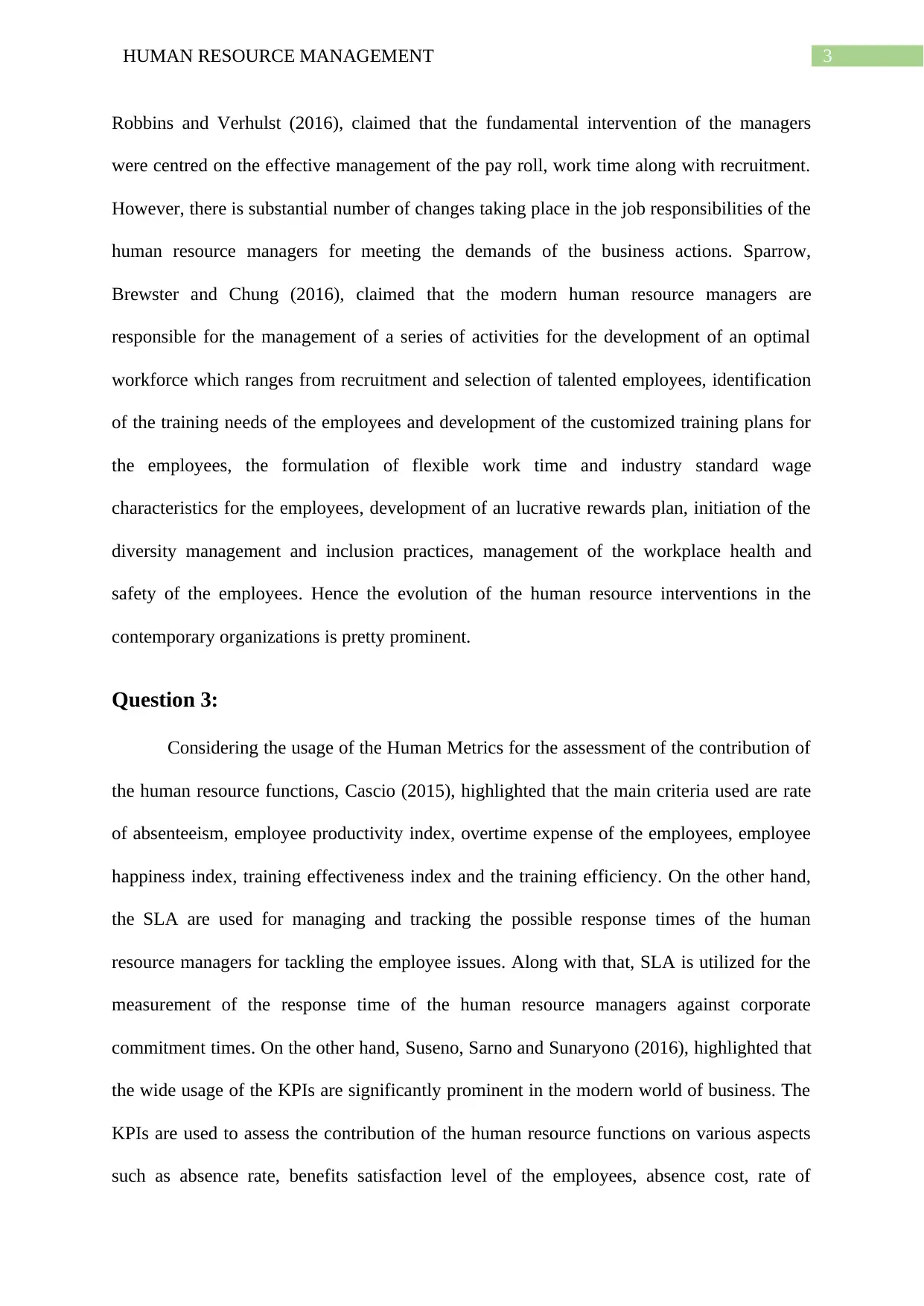
3HUMAN RESOURCE MANAGEMENT
Robbins and Verhulst (2016), claimed that the fundamental intervention of the managers
were centred on the effective management of the pay roll, work time along with recruitment.
However, there is substantial number of changes taking place in the job responsibilities of the
human resource managers for meeting the demands of the business actions. Sparrow,
Brewster and Chung (2016), claimed that the modern human resource managers are
responsible for the management of a series of activities for the development of an optimal
workforce which ranges from recruitment and selection of talented employees, identification
of the training needs of the employees and development of the customized training plans for
the employees, the formulation of flexible work time and industry standard wage
characteristics for the employees, development of an lucrative rewards plan, initiation of the
diversity management and inclusion practices, management of the workplace health and
safety of the employees. Hence the evolution of the human resource interventions in the
contemporary organizations is pretty prominent.
Question 3:
Considering the usage of the Human Metrics for the assessment of the contribution of
the human resource functions, Cascio (2015), highlighted that the main criteria used are rate
of absenteeism, employee productivity index, overtime expense of the employees, employee
happiness index, training effectiveness index and the training efficiency. On the other hand,
the SLA are used for managing and tracking the possible response times of the human
resource managers for tackling the employee issues. Along with that, SLA is utilized for the
measurement of the response time of the human resource managers against corporate
commitment times. On the other hand, Suseno, Sarno and Sunaryono (2016), highlighted that
the wide usage of the KPIs are significantly prominent in the modern world of business. The
KPIs are used to assess the contribution of the human resource functions on various aspects
such as absence rate, benefits satisfaction level of the employees, absence cost, rate of
Robbins and Verhulst (2016), claimed that the fundamental intervention of the managers
were centred on the effective management of the pay roll, work time along with recruitment.
However, there is substantial number of changes taking place in the job responsibilities of the
human resource managers for meeting the demands of the business actions. Sparrow,
Brewster and Chung (2016), claimed that the modern human resource managers are
responsible for the management of a series of activities for the development of an optimal
workforce which ranges from recruitment and selection of talented employees, identification
of the training needs of the employees and development of the customized training plans for
the employees, the formulation of flexible work time and industry standard wage
characteristics for the employees, development of an lucrative rewards plan, initiation of the
diversity management and inclusion practices, management of the workplace health and
safety of the employees. Hence the evolution of the human resource interventions in the
contemporary organizations is pretty prominent.
Question 3:
Considering the usage of the Human Metrics for the assessment of the contribution of
the human resource functions, Cascio (2015), highlighted that the main criteria used are rate
of absenteeism, employee productivity index, overtime expense of the employees, employee
happiness index, training effectiveness index and the training efficiency. On the other hand,
the SLA are used for managing and tracking the possible response times of the human
resource managers for tackling the employee issues. Along with that, SLA is utilized for the
measurement of the response time of the human resource managers against corporate
commitment times. On the other hand, Suseno, Sarno and Sunaryono (2016), highlighted that
the wide usage of the KPIs are significantly prominent in the modern world of business. The
KPIs are used to assess the contribution of the human resource functions on various aspects
such as absence rate, benefits satisfaction level of the employees, absence cost, rate of
Paraphrase This Document
Need a fresh take? Get an instant paraphrase of this document with our AI Paraphraser
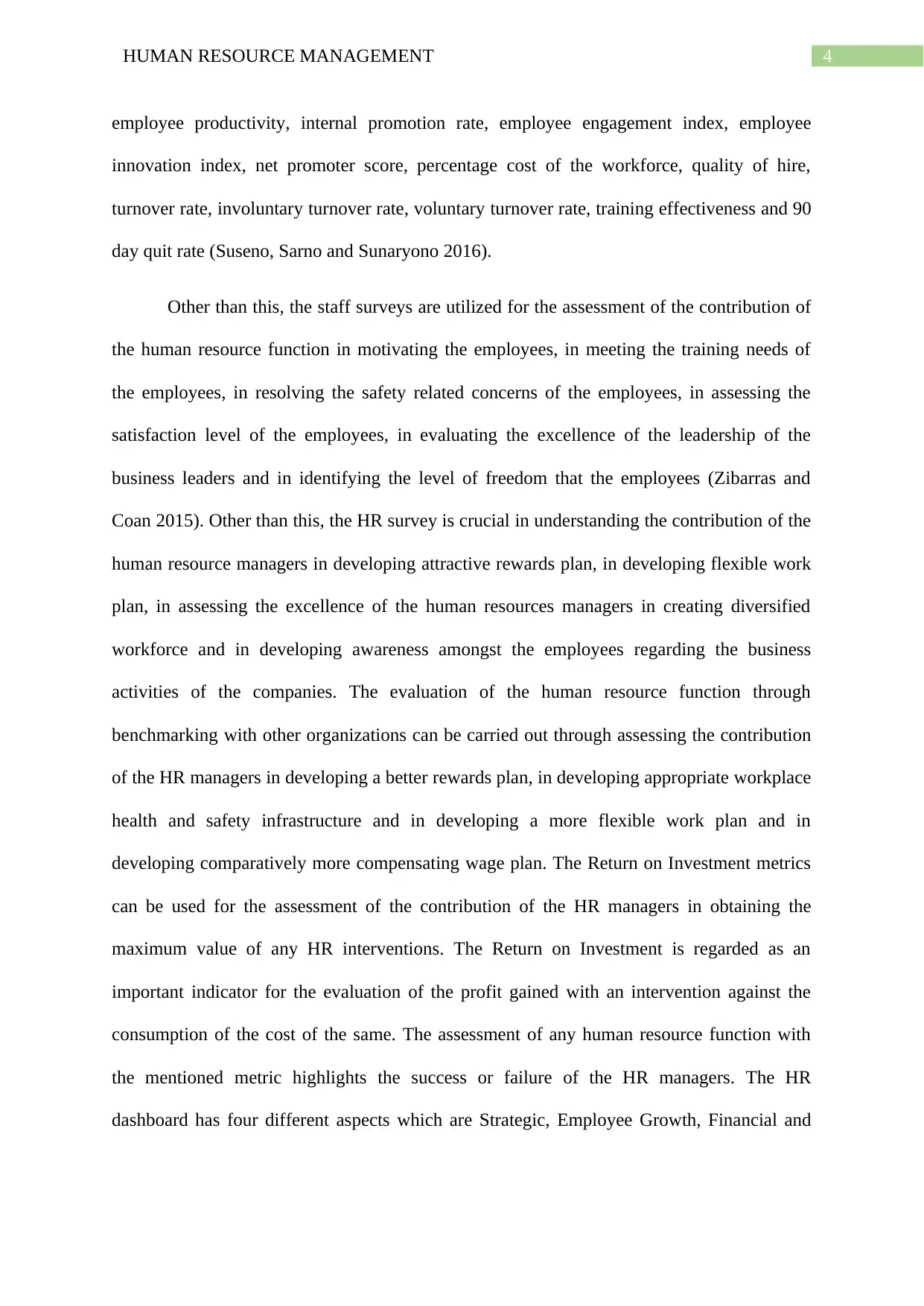
4HUMAN RESOURCE MANAGEMENT
employee productivity, internal promotion rate, employee engagement index, employee
innovation index, net promoter score, percentage cost of the workforce, quality of hire,
turnover rate, involuntary turnover rate, voluntary turnover rate, training effectiveness and 90
day quit rate (Suseno, Sarno and Sunaryono 2016).
Other than this, the staff surveys are utilized for the assessment of the contribution of
the human resource function in motivating the employees, in meeting the training needs of
the employees, in resolving the safety related concerns of the employees, in assessing the
satisfaction level of the employees, in evaluating the excellence of the leadership of the
business leaders and in identifying the level of freedom that the employees (Zibarras and
Coan 2015). Other than this, the HR survey is crucial in understanding the contribution of the
human resource managers in developing attractive rewards plan, in developing flexible work
plan, in assessing the excellence of the human resources managers in creating diversified
workforce and in developing awareness amongst the employees regarding the business
activities of the companies. The evaluation of the human resource function through
benchmarking with other organizations can be carried out through assessing the contribution
of the HR managers in developing a better rewards plan, in developing appropriate workplace
health and safety infrastructure and in developing a more flexible work plan and in
developing comparatively more compensating wage plan. The Return on Investment metrics
can be used for the assessment of the contribution of the HR managers in obtaining the
maximum value of any HR interventions. The Return on Investment is regarded as an
important indicator for the evaluation of the profit gained with an intervention against the
consumption of the cost of the same. The assessment of any human resource function with
the mentioned metric highlights the success or failure of the HR managers. The HR
dashboard has four different aspects which are Strategic, Employee Growth, Financial and
employee productivity, internal promotion rate, employee engagement index, employee
innovation index, net promoter score, percentage cost of the workforce, quality of hire,
turnover rate, involuntary turnover rate, voluntary turnover rate, training effectiveness and 90
day quit rate (Suseno, Sarno and Sunaryono 2016).
Other than this, the staff surveys are utilized for the assessment of the contribution of
the human resource function in motivating the employees, in meeting the training needs of
the employees, in resolving the safety related concerns of the employees, in assessing the
satisfaction level of the employees, in evaluating the excellence of the leadership of the
business leaders and in identifying the level of freedom that the employees (Zibarras and
Coan 2015). Other than this, the HR survey is crucial in understanding the contribution of the
human resource managers in developing attractive rewards plan, in developing flexible work
plan, in assessing the excellence of the human resources managers in creating diversified
workforce and in developing awareness amongst the employees regarding the business
activities of the companies. The evaluation of the human resource function through
benchmarking with other organizations can be carried out through assessing the contribution
of the HR managers in developing a better rewards plan, in developing appropriate workplace
health and safety infrastructure and in developing a more flexible work plan and in
developing comparatively more compensating wage plan. The Return on Investment metrics
can be used for the assessment of the contribution of the HR managers in obtaining the
maximum value of any HR interventions. The Return on Investment is regarded as an
important indicator for the evaluation of the profit gained with an intervention against the
consumption of the cost of the same. The assessment of any human resource function with
the mentioned metric highlights the success or failure of the HR managers. The HR
dashboard has four different aspects which are Strategic, Employee Growth, Financial and
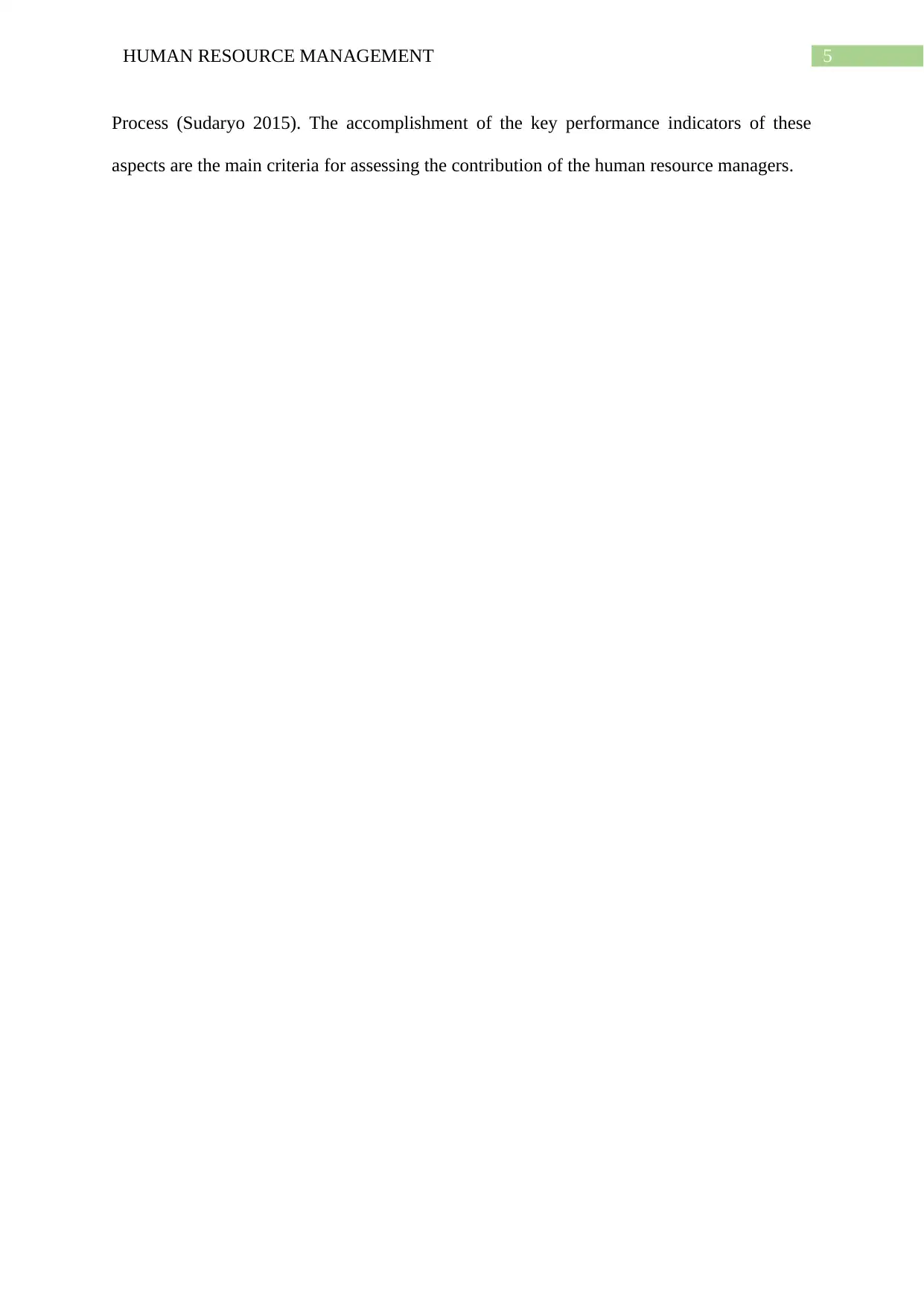
5HUMAN RESOURCE MANAGEMENT
Process (Sudaryo 2015). The accomplishment of the key performance indicators of these
aspects are the main criteria for assessing the contribution of the human resource managers.
Process (Sudaryo 2015). The accomplishment of the key performance indicators of these
aspects are the main criteria for assessing the contribution of the human resource managers.
⊘ This is a preview!⊘
Do you want full access?
Subscribe today to unlock all pages.

Trusted by 1+ million students worldwide
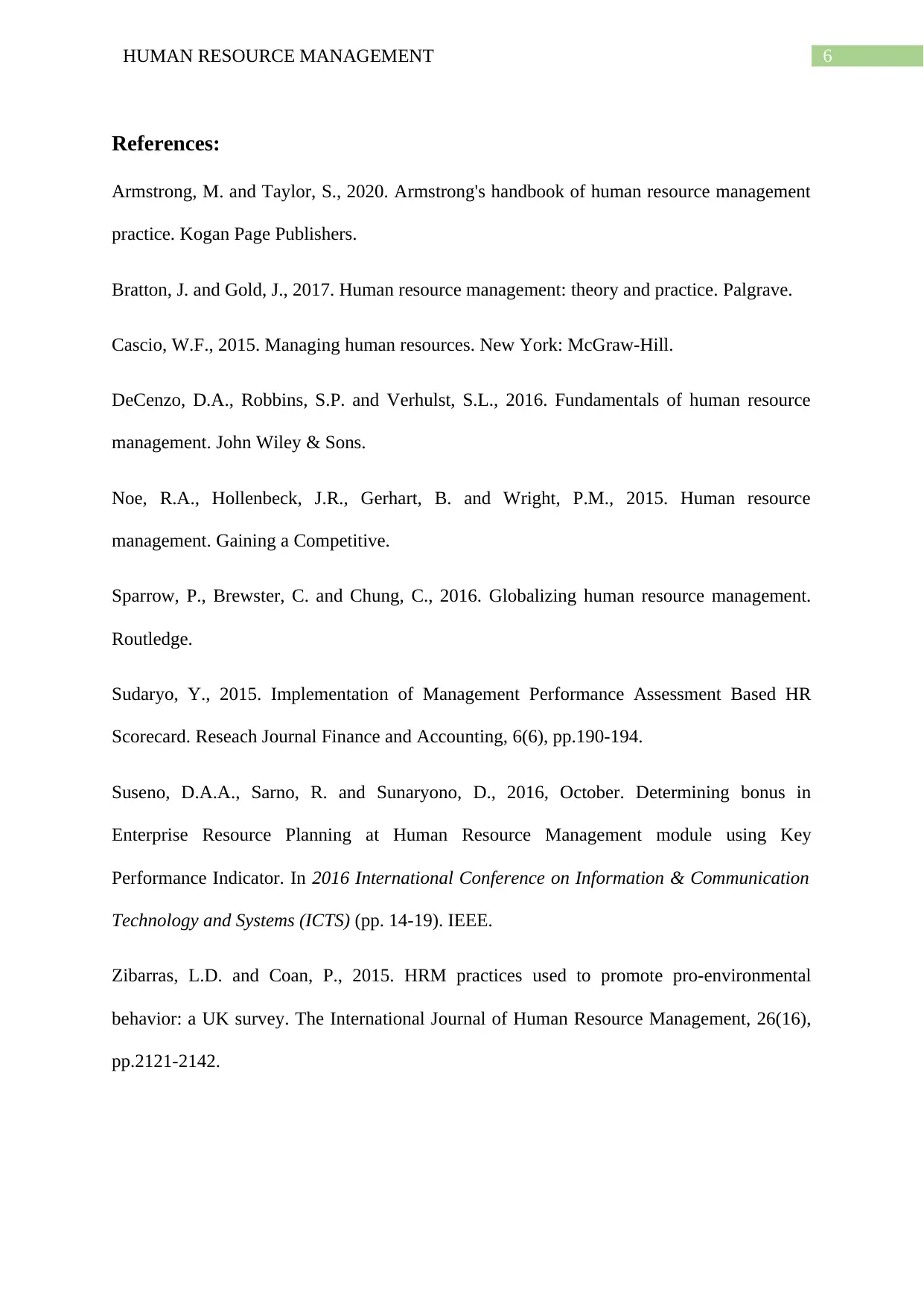
6HUMAN RESOURCE MANAGEMENT
References:
Armstrong, M. and Taylor, S., 2020. Armstrong's handbook of human resource management
practice. Kogan Page Publishers.
Bratton, J. and Gold, J., 2017. Human resource management: theory and practice. Palgrave.
Cascio, W.F., 2015. Managing human resources. New York: McGraw-Hill.
DeCenzo, D.A., Robbins, S.P. and Verhulst, S.L., 2016. Fundamentals of human resource
management. John Wiley & Sons.
Noe, R.A., Hollenbeck, J.R., Gerhart, B. and Wright, P.M., 2015. Human resource
management. Gaining a Competitive.
Sparrow, P., Brewster, C. and Chung, C., 2016. Globalizing human resource management.
Routledge.
Sudaryo, Y., 2015. Implementation of Management Performance Assessment Based HR
Scorecard. Reseach Journal Finance and Accounting, 6(6), pp.190-194.
Suseno, D.A.A., Sarno, R. and Sunaryono, D., 2016, October. Determining bonus in
Enterprise Resource Planning at Human Resource Management module using Key
Performance Indicator. In 2016 International Conference on Information & Communication
Technology and Systems (ICTS) (pp. 14-19). IEEE.
Zibarras, L.D. and Coan, P., 2015. HRM practices used to promote pro-environmental
behavior: a UK survey. The International Journal of Human Resource Management, 26(16),
pp.2121-2142.
References:
Armstrong, M. and Taylor, S., 2020. Armstrong's handbook of human resource management
practice. Kogan Page Publishers.
Bratton, J. and Gold, J., 2017. Human resource management: theory and practice. Palgrave.
Cascio, W.F., 2015. Managing human resources. New York: McGraw-Hill.
DeCenzo, D.A., Robbins, S.P. and Verhulst, S.L., 2016. Fundamentals of human resource
management. John Wiley & Sons.
Noe, R.A., Hollenbeck, J.R., Gerhart, B. and Wright, P.M., 2015. Human resource
management. Gaining a Competitive.
Sparrow, P., Brewster, C. and Chung, C., 2016. Globalizing human resource management.
Routledge.
Sudaryo, Y., 2015. Implementation of Management Performance Assessment Based HR
Scorecard. Reseach Journal Finance and Accounting, 6(6), pp.190-194.
Suseno, D.A.A., Sarno, R. and Sunaryono, D., 2016, October. Determining bonus in
Enterprise Resource Planning at Human Resource Management module using Key
Performance Indicator. In 2016 International Conference on Information & Communication
Technology and Systems (ICTS) (pp. 14-19). IEEE.
Zibarras, L.D. and Coan, P., 2015. HRM practices used to promote pro-environmental
behavior: a UK survey. The International Journal of Human Resource Management, 26(16),
pp.2121-2142.
1 out of 7
Related Documents
Your All-in-One AI-Powered Toolkit for Academic Success.
+13062052269
info@desklib.com
Available 24*7 on WhatsApp / Email
![[object Object]](/_next/static/media/star-bottom.7253800d.svg)
Unlock your academic potential
Copyright © 2020–2025 A2Z Services. All Rights Reserved. Developed and managed by ZUCOL.



